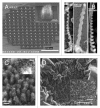Nanocarbon surfaces for biomedicine
- PMID: 24646883
- PMCID: PMC4091123
- DOI: 10.4161/biom.28537
Nanocarbon surfaces for biomedicine
Abstract
The distinctive physicochemical, mechanical and electrical properties of carbon nanostructures are currently gaining the interest of researchers working in bioengineering and biomedical fields. Carbon nanotubes, carbon dendrimers, graphenic platelets and nanodiamonds are deeply studied aiming at their application in several areas of biology and medicine. Here we provide a summary of the carbon nanomaterials prepared in our labs and of the fabrication techniques used to produce several biomedical utilities, from scaffolds for tissue growth to cargos for drug delivery and to biosensors.
Keywords: bio-nanomaterials; carbon nanostructures; nanomedicine; scaffolds.
Figures




References
-
- Singh SK, Kulkarni PP, Dash D. Biomedical applications of nanomaterials: an overview, in Bio-Nanotechnology: A Revolution in Food, Biomedical and Health Sciences (Bagchi D, Bagchi M, Moriyama H, Shahidi F, editor). Oxford: Blackwell Publishing Ltd.; 2013. 856p.
-
- Guglielmotti V, Orlanducci S, Tamburri E, Cianchetta I, Gay S, Lavecchia T, Reina G, Passeri D, Rossi M, Terranova ML. CVD-based techniques for the synthesis of nanographites and nanodiamonds. Nuovo Cim. 2013;36C:3–9.
-
- Matassa R, Orlanducci S, Tamburri E, Guglielmotti V, Sordi D, Terranova ML, Rossi M. Characterization of carbon structures produced by graphene self-assembly. J Appl Cryst. 2014;47:222–7. doi: 10.1107/S1600576713029488. - DOI
Publication types
MeSH terms
Substances
LinkOut - more resources
Full Text Sources
Other Literature Sources
